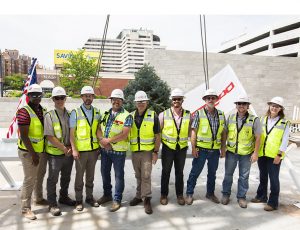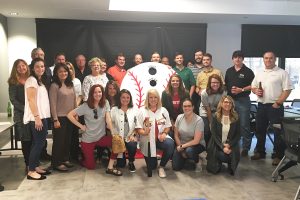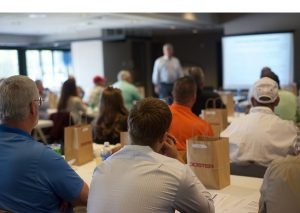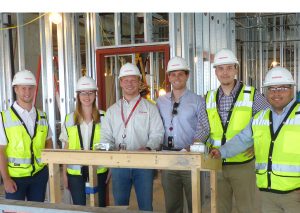In response to the rising demand for mixed use in the United States
The pendulum swings…In America, we tend to flock from one extreme to the other. We see what appears to no longer serve our needs and wants, and turn 180 degrees in hopes that “things” will get better. We do not have the ability to fundamentally switch from suburban sprawl to urban living in a short time, but it seems as though Americans are making the 180 degree turn back to the city center. Since the 1940’s our “Futurama American Dream” has been an experiment, a social experiment that was a huge success in terms of every American family owning a home with a car in the driveway. The greatest part of achieving this success is that capitalism was the driver in every way. New jobs were created, new creative financing was accepted, and suddenly we could afford homes and cars. Since the 1950’s America has grown in the same suburban pattern through all of the political and economic cycles. For over 50 years we have pushed in one direction away from the city center, and out where land and homes are cheap. After 50 years we, as the consumers, are beginning to see the flaws in this suburban sprawl, or at least seeing the unsustainability of this continued pattern of growth. It appears that the shift from suburban to urban will take place, but it will be limited by affordability. Urbanism is taking on the forms of many mixed uses, and there is no single answer or approach to creating this huge shift from suburban to urban. The markets and financing will determine what becomes successful.
As I mentioned before, capitalism is responsible for the prosperous growth of the American Dream. The public market responded well to what was offered as a 180 degree turn from the inner city conditions of the 1930’s and 1940’s in the Futurama plan at the World’s Fair. This plan was financed and marketed by General Motors, and offered a wonderful alternative to the depression and WWII era that had been facing Americans. Henry Ford had also created entire communities to run his automotive manufacturing plants. I think that both General Motors and Ford have been great for this country: they have created jobs, improved lives, and created retirement plans and pensions for many Americans. Though we could go into the many successes and failures of both GM and Ford the point that I am making is jobs. Could any of this growth to suburbia have been possible without the interstate and the automobile, and the jobs that both created? Jobs and income are the drivers to our successes and creation of urban and suburban growth. Take a look at Silicon Valley, CA and Austin, TX. Austin, TX has exploded as a city by becoming a tech centered city. Austin has also experienced huge success in the creation of urbanism. Between The University of Texas and the tech community, Austin’s downtown area has flourished with new apartments, student housing, and all of the growth that follows those rooftops. The outer city of Austin has also swelled with new homes, retail centers, and offices. Austin is a formidable competitor for workers to Silicon Valley. There has been almost proportionally equal growth into the city as well as towards suburbia. Let’s also take a look at southeastern America as well. BMW’s are built in South Carolina, Honda’s are built in Alabama, and Toyota’s and Nissan’s are built in Mississippi. These new jobs are changing the areas that they are in, but land is cheap and plentiful in the south. Suburbia will most likely continue to grow in these more rural areas for many reasons, but mainly for a lack of city center to begin with. Should we allow this suburban sprawl to continue and expand? Do we have control over how it grows at all? I agree with, Christopher Leinberger, our governing officials have encouraged the suburban growth in the past with incentives, highway and road construction, and zoning rules and regulations. Keep in mind though that; jobs, employment, and money are the drivers of the urban vs. suburban questions and solutions. As our cities and counties work very hard to attract jobs and economic growth, the same effort needs to go into creating a plan to develop housing, transportation, and health care facilities. The mixed use communities are the best answer to new growth, and developers will respond to a good plan that cities can use to encourage good inward growth. Even if we cannot eliminate the need for a commute to work we can eliminate the need to have to get in the car for our every need and want. Somewhere in between urbanism and suburbia a closer and tighter community can be developed, and the market seems to be demanding it.
Some new factors that are going to weigh heavily on the future of growth in either direction are emerging on the scene quickly. Internet sales and its effect on retail space have most professional retail developers and operators baffled today. Will retail centers become merely a drop off point for internet orders? Also, driverless cars will be emerging soon. There are several prototypes being tested as we speak. Will the infrastructure for this technology reach all the way out to the suburbs? If I did not have to drive, but instead could respond to emails, or spend time with the kids on the way to school; would a commute still bother me? The wealthy portion that lives in the “Favored Quarter” will determine how most of this will play out as they will be the first market to afford these luxuries. The speculations on these two future factors are endless, but the fact that they are coming soon is real. I believe that it is difficult to discuss future development without discussing what the future will look like. We are technologically changing faster than ever before and the pace will continue to get faster each year in the future. A more mixed use community with walkable local services appears to be the most viable solution. As we order most of our consumer goods via the internet, and spend less time in the car; the local economy will have to come back strong by filling small shops and produce markets with more local goods. Urban density in the core of the city will continue to grow on the macro level, and the suburban areas will slowly replace surface parked shopping centers with mixed use residential, retail and office. This is also becoming a reality as we speak. Even healthcare is changing rapidly with the mixed use movement. The changes in our healthcare system are forcing rural hospitals to close down, and the days of adding 750 beds to an existing hospital are gone. Large hospitals are being replaced by smaller stand-alone emergency care centers. Urbanism is going to have to take on many different faces as we convert from suburbia.
The last and perhaps the most important piece of this puzzle is the unintended lack of affordable housing that urbanism is providing. The rents and sale prices of the urban infill/mixed use projects are ever increasing. At some point the increasing rents will slow, but reaching affordability for most is out of the question. This is why I believe that more than half of our population will not be able to subscribe to urbanism. Land costs are going to continue to rise, and unless building construction can become more automated the cost of construction will rise with it. As the urbanism trend continues, fueled by the cost of petroleum and where the jobs are, affordable housing becomes more difficult. This urban change could force the displacement of working class communities out to “the drive until you qualify areas” creating the exact opposite of the original 1980’s flight from the cities. I personally am interested in how we can create work force housing. It is a shame that the term “affordable housing” has been taken by the subsidized market. The term affordable housing should be just that, housing that the working man can afford to live in. This is an issue that I hope to see solutions for. The solution will most likely not show up in the center of a downtown area, but how do we create a nice living space for the working man? Urbanism is here, and there is no doubt that it is here to stay. Americans will likely be equally split on the Urban vs. Suburban decision. This will hopefully keep us near the center as our mixed use communities grow towards one another in a more dense and efficient community.
Click here to learn more about Doster’s expertise in mixed use construction.



